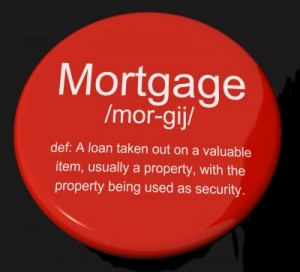 A mortgage loan is a loan secured by real property through the use of a mortgage note which evidences the existence of the loan and the encumbrance of that realty. However, in everyday usage the word mortgage alone is used to mean “mortgage loan”.
A mortgage loan is a loan secured by real property through the use of a mortgage note which evidences the existence of the loan and the encumbrance of that realty. However, in everyday usage the word mortgage alone is used to mean “mortgage loan”.
A home buyer can obtain financing (a “mortgage”) from a financial institution to purchase a property, either directly or indirectly through intermediaries. Features of mortgage loans such as the size of the loan, loan maturity, interest rate, method of paying off the loan, and other characteristics can vary considerably and are generally determined by market conditions and negotiation.
Mortgage loan basics
Basic concepts and legal regulation
In the U.S. mortgages are amortized over a set period of time, typically 30 years although other time periods are generally available such as 15 and 10 years. All types of real property can be, and usually are, secured with a mortgage.
Lenders will quote rates based on a combination of market conditions, including the prime lending rate and the lender’s estimate of the risk involved with the particular property and borrower.
Mortgage lending is the primary mechanism used in many countries to finance private ownership of residential and commercial property (see commercial mortgages). Although the terminology and precise forms will differ from country to country, the basic components tend to be similar:
- Property: the physical residence being financed. The exact form of ownership will vary from country to country, and may restrict the types of lending that are possible.
- mortgage insurance, or pay off outstanding debt before selling the property.
- Borrower: the person borrowing who either has or is creating an ownership interest in the property. He will create a debt under the terms of the mortgage loan to the lender.
- Lender: any lender, but usually a bank or other financial institution. Lenders may also be investors who own an interest in the mortgage through a mortgage-backed security. In such a situation, the initial lender is known as the mortgage originator, which then packages and sells the loan to investors. The payments from the borrower are thereafter collected by a loan servicer.
- Principal: the original amount of the loan.
- Interest: a financial charge for use of the lender’s money.
- repossession: the act of a lender foreclosing, i.e. seize the property due to failure by the borrower to meet the obligations of the loan.
- Completion: legal completion of the mortgage deed, and hence the start of the mortgage.
- Redemption: final repayment of the amount outstanding, which may be a “natural redemption” at the end of the scheduled term or a lump sum redemption, typically when the borrower decides to sell the property. a closed mortgage account is said to be “redeemed”.
Mortgage loans are generally structured as long-term loans, the periodic payments for which are similar to an amortization.
Mortgage lending will also take into account the (perceived) riskiness of the mortgage loan, that is, the likelihood that the funds will be repaid (usually considered a function of the creditworthiness of the borrower). Other factors include the loan to value ratio so that if the mortgage is not repaid, the lender will be able to foreclose and recoup all of its original capital even if the market declines in the interim.
Mortgage loan types
The two basic types of amortized loans are fixed rate and variable rate mortgage (or adjustable rate mortgage). In some countries, such as the United States, fixed rate mortgages are the norm, but floating rate mortgages are relatively common. Combinations of fixed and floating rate mortgages are also common, whereby a mortgage loan will have a fixed rate for some period, for example the first five years, and vary after the end of that period.
- In a fixed rate mortgage, the interest rate, and hence periodic payment, remains fixed for the life (or term) of the loan. Therefore the payment is fixed, although ancillary costs (such as property taxes and insurance) can and do change. For a fixed rate mortgage, payments for principal and interest should not change over the life of the loan,
- In an adjustable rate mortgage, the interest rate is generally fixed for a period of time, after which it will periodically (for example, every year, two years or 5 year) adjust up or down to some market index. Adjustable rates transfer part of the interest rate risk from the lender to the borrower, and thus are widely used where fixed rate funding is difficult to obtain or prohibitively expensive. Since the risk is transferred to the borrower, the initial interest rate may be, for example, 0.5% to 2% lower than the average 30-year fixed rate; the size of the price differential will be related to debt market conditions.
The charge to the borrower depends upon the credit risk in addition to the interest rate risk. The mortgage origination and underwriting process involves checking credit scores, debt-to-income, down-payments, and assets. Jumbo mortgages and sub-prime lending are not supported by government guarantees and face higher interest rates. Other innovations described below can affect the rates as well.
See Mortgage Jargon for a list of hundreds of Mortgage related Terms and definitions.
This article uses material from the Wikipedia article Mortgage, which is released under the Creative Commons Attribution-Share-Alike License 3.0.
Image courtesy of Stuart Miles / FreeDigitalPhotos.net
